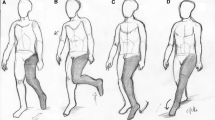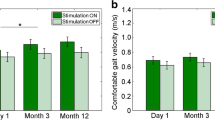Abstract
Introduction
Unlike the drop foot therapy with ortheses, the therapeutic effect of an implantable peroneus nerve stimulator (iPNS) is not well described. IPNS is a dynamic therapy option which is placed directly to the motoric part of the peroneal nerve and evokes a dorsiflexion of the paralysed foot. This retrospective study evaluates the kinematics and kinetics in drop foot patients who were treated with an iPNS.
Materials and methods
18 subjects (mean age 51.3 years) with a chronic stroke-related drop foot were treated with an implantable peroneal nerve stimulator. After a mean follow-up from 12.5 months, kinematics and kinetics as well as spatiotemporal parameters were evaluated and compared in activated and deactivated iPNS. Therefore, a gait analysis with motion capture system (Vicon Motion System Ltd®, Oxford, UK) and Plug-in-Gait model was performed.
Results
The study showed significantly improved results in ankle dorsiflexion from 6.8° to 1.8° at the initial contact and from −7.3° to 0.9° during swing phase (p ≤ 0.004 and p ≤ 0.005, respectively). Likewise, we could measure improved kinetics, i.a. with a statistically significant improvement in vertical ground reaction force at loading response from 99.76 to 106.71 N/kg (p = 0.043). Enhanced spatiotemporal results in cadence, douple support, stride length, and walking speed could also be achieved, but without statistical significance (p > 0.05).
Conclusions
The results show statistically significant improvement in ankle dorsiflexion and vertical ground reaction forces. These facts indicate a more gait stability and gait efficacy. Therefore, the use of an iPNS appears an encouraging therapeutic option for patients with a stroke-related drop foot.





Similar content being viewed by others
References
Murray CJL, Vos T, Lozano R, Naghavi M, Flaxman AD, Michaud C et al (2012) Disability-adjusted life years (DALYs) for 291 diseases and injuries in 21 regions, 1990–2010: a systematic analysis for the Global Burden of Disease Study 2010. Lancet 380:2197–2223
Hyndman D, Ashburn A, Stack E (2002) Fall events among people with stroke living in the community: circumstances of falls and characteristics of fallers. Arch Phys Med Rehabil 83:165–170
Fatone S, Gard SA, Malas BS (2009) Effect of ankle-foot orthosis alignment and foot-plate length on the gait of adults with poststroke hemiplegia. Arch Phys Med Rehabil 90:810–818
Cheng PT, Chen CL, Wang CM, Hong WH (2004) Leg muscle activation patterns of sit-to-stand movement in stroke patients. Am J Phys Med Rehabil 83:10–16
Franceschini M, Massucci M, Ferrari L, Agosti M, Paroli C (2003) Effects of an ankle-foot orthosis on spatiotemporal parameters and energy cost of hemiparetic gait. Clin Rehabil 17:368–372
Sheffler LR, Taylor PN, Gunzler DD, Buurke JH, IJzerman MJ, Chae J (2013) Randomized controlled trial of surface peroneal nerve stimulation for motor relearning in lower limb hemiparesis. Arch Phys Med Rehabil 94:1007–1014
Mulroy SJ, Eberly VJ, Gronely JK, Weiss W, Newsam CJ (2010) Effect of AFO design on walking after stroke: impact of ankle plantar flexion on tracture. Prosthet Orthot Int 34:277–292
Hesse S, Werner C, Matthias K, Stephen K, Berteanu M (1999) Non-velocity-related effects of a rigid double-stopped anklefoot orthosis on gait and lower limb muscle activity of hemiparetic subjects with an equinovarus deformity. Stroke 30:1855–1861
Cattaneo D, Marazzini F, Crippa A, Cardini R (2002) Do static or dynamic AFOs improve balance? Clin Rehabil 16:894–899
Esquenazi A, Ofluoglu D, Hirai B, Kim S (2009) The effect of an ankle-foot orthosis on temporal spatial parameters and asymmetry of gait in hemiparetic patients. PM R 1:1014–1018
Ferreira LA, Neto HP, Grecco LA et al (2013) Effect of ankle-foot orthosis on gait velocity and cadence of stroke patients: a systematic review. J Phys Ther Sci 25:1503–1508
Doğan A, Mengüllüoğlu M, Özgirgin N (2011) Evaluation of the effect of ankle-foot orthosis use on balance and mobility in hemiparetic stroke patients. Disabil Rehabil 33:1433–1439
Janssen WG, Bussmann HB, Stam HJ (2002) Determinants of the sit-to-stand movement: a review. Phys Ther 82:866–879
Given JD, Dewald JP, Rymer WZ (1995) Joint dependent passive stiffness in paretic and contralateral limbs of spastic patients with hemiparetic stroke. J Neurol Neurosurg Psychiatry 59:271–279
Miller EL, Murray L, Richards L, Zorowitz RD, Bakas T, Clark P et al (2010) Comprehensive overview of nursing and interdisciplinary rehabilitation care of the stroke patient: a scientific statement from the American Heart Association. Stroke 41:2402–2448
van Swigchem R, Vloothuis J, den Boer J, Weerdesteyn V, Geurts AC (2010) Is transcutaneous peroneal stimulation beneficial to patients with chronic stroke using an ankle foot orthosis? A within-subjects study of patients’ satisfaction, walking speed and physical activity level. J Rehabil Med 42:117–121
Ring H, Treger I, Gruendlinger L, Hausdorff JM (2009) Neuroprosthesis for footdrop compared with an ankle-foot orthosis: effects on postural control during walking. J Stroke Cerebrovasc Dis 18:41–47
Feigin VL, Lawes CM, Bennett DA, Barker-Collo SL, Paraq V (2009) Worldwide stroke incidence and early case fatality reported in 56 population-based studies: a systematic review. Lancet Neurol 8:355–369
Sheffler LR, Bailey SN, Wilson RD, Chae J (2013) Spatiotemporal, kinematic, and kinetic effects of a peroneal nerve stimulator versus an ankle foot orthosis in hemiparetic gait. Neurorehabil Neural Repair 27:403–410
Bethoux F, Rogers HL, Nolan KJ, Abrams GM, Annaswamy TM, Brandstater M et al (2015) Long-term follow-up to a randomized controlled trial comparing peroneal nerve functional electrical stimulation to an ankle foot orthosis for patients with chronic stroke. Neurorehabil Neural Repair 29:911–922
Burridge JH, Haugland M, Larsen B, Svaneborg N, Iversen HK, Christensen PB et al (2008) Patients’ perceptions of the benefits and problems of using the ActiGait implanted drop-foot stimulator. J Rehabil Med 40:873–875
Martin KD, Polanski WH, Schulz AK, Jöbges M, Hoff H, Schackert G, Pinzer T, Sobottka SB (2015) Restoration of ankle movements with the ActiGait implantable foot drop stimulator: a safe and reliable treatment option for permanent central leg palsy. J Neurosurg 24:1–7
Baumbach SF, Braunstein M, Seeliger F, Borgmann L, Böcker W, Polzer H (2016) Ankle dorsiflexion: what is normal? Development of a decision pathway for diagnosing impaired ankle dorsiflexion and M. gastrocnemius tightness. Arch Orthop Trauma Surg 136(9):1203–1211
Ernst J, Grundey J, Hewitt M, von Lewinski F, Kaus J, Schmalz T, Rohde V, Liebetanz D (2013) Towards physiological ankle movements with the ActiGait implantable foot drop stimulator in chronic stroke. Restor Neurol Neurosci 31:557–569
Hausdorff JM, Ring H (2008) Effects of a new radio frequency-controlled neuroprosthesis on gait symmetry and rhythmicity in patients with chronic hemiparesis. Am J Phys Med Rehabil 87:4–13
Stein RB, Everaert DG, Thompson AK et al (2010) Long-term therapeutic and orthotic effects of a foot drop stimulator on walking performance in progressive and nonprogressive neurological disorders. Neurorehabil Neural Repair 24:152–167
Author information
Authors and Affiliations
Corresponding author
Ethics declarations
Funding
This study was funded by the company NSTIM GmbH (Grant Number 19510242).
Conflict of interest
In the past Author K.D. has received research grants from the Company NSTIM. Furthermore, he has received a speaker honorarium from Company NSTIM. Financial support for attending symposia—Yes, Financial support for educational programs—No, Employment or consultation—Yes, Support from a project sponsor—Yes, s. Above, Position on advisory board or board of directors or other type of management relationships—No, Multiple affiliations—No, Financial relationships, for example equity ownership or investment interest—No, Intellectual property rights (e.g., patents, copyrights, and royalties from such rights)—No, Holdings of spouse and/or children that may have financial interest in the work—No.
Ethical approval
2489-2014.
Informed consent
Informed consent was obtained from all individual participants included in the study.
Rights and permissions
About this article
Cite this article
Daniilidis, K., Jakubowitz, E., Thomann, A. et al. Does a foot-drop implant improve kinetic and kinematic parameters in the foot and ankle?. Arch Orthop Trauma Surg 137, 499–506 (2017). https://doi.org/10.1007/s00402-017-2652-8
Received:
Published:
Issue Date:
DOI: https://doi.org/10.1007/s00402-017-2652-8




